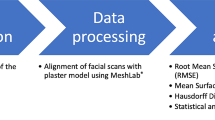Abstract
Background
This report describes preoperative digital planning for rhinoplasty using a new three-dimensional (3D) radiologic viewer that allows both patients and surgeons to visualize on a common monitor the 3D real aspect of the nose in its inner and outer sides.
Methods
In the period 2002 to 2008, 210 patients underwent rhinoplasty procedures in the authors’ clinic. The patients were randomly divided into three groups according to the type of preoperative planning used: photos only, a simulated result by Adobe Photoshop, or the 3D radiologic viewer. The parameters evaluated included the number of patients that underwent surgery after the first consultation, the number of patients who asked for a reintervention, patient satisfaction (according to a test given to the patients 12 months postoperatively), the surgical time required for a functional intervention, and the improvement in nasal function by postoperative rhinomanometry and subjective evaluation.
Results
Computer-aided technologies led to a higher number of patients deciding to undergo a rhinoplasty. Simulation of the postoperative results was not as useful in the postoperative period due to the higher number of reintervention requests.
Conclusion
The patients undergoing rhinoplasties preferred new technologies in the preoperative period. The advantages of using the 3D radiologic viewer included improved preoperative planning, reduction in intraoperative stress, a higher number of patients undergoing surgery, reduction in postoperative surgical corrections, reduction in surgical time for the functional intervention, a higher rate of improvement in nasal function, a higher percentage of postoperative satisfaction, and reduced costs.





Similar content being viewed by others
References
Bronz G (1994) Predictability of the computer imaging system in primary rhinoplasty. Aesth Plast Surg 18:175–181
Byrd HS, Hobar PC (1993) Rhinoplasty: A practical guide for surgical planning. Plast Reconstr Surg 91:642
Chatfield C (1983) Statistics for Technology, 3rd edn. Kluwer Academic Publishers, Dordrecht, The Netherlands, pp 148–155
Chavez AE, Dagum P, Koch RJ et al (1997) Legal issues of computer imaging in plastic surgery: A primer. Plast Reconstr Surg 100:1601–1609
Constantian MB (1987) A model for planning rhinoplasty. Plast Reconstr Surg 79:472
Farkas LG, Hreczko TA, Kolar JC et al (1985) Vertical and horizontal proportions of the face in young adult North American Caucasians: Revision of neoclassical canons. Plast Reconstr Surg 75:328
Farkas LG, Kolar JC (1987) Anthropometrics and art in the aesthetics of women’s faces. Clin Plast Surg 14:599
Gregory M, Galdino MD, DaSilva D, Gunter JP (2002) Digital photography for rhinoplasty. Plast Reconstr Surg 109:1421–1434
Guyuron B (1988) Precision rhinoplasty: Part I. The role of life-size photographs and soft tissue cephalometric analysis. Plast Reconstr Surg 81:489
Guyuron B (1988) Precision rhinoplasty: Part II. Prediction. Plast Reconstr Surg 81:500
Gonzalez-Ulloa M (1962) Quantitative principles in cosmetic surgery of the face (profile-plasty). Plast Reconstr Surg 29:2
Joseph J (1931) Nasenplastik und Sonstige Gesichtsplastik. Verlag von Curt Kabitzsch, Leipzig
Kavagiou Z, Bello F, Scott G, Hamann J, Roberts D (2005) Facial plastic surgery planning using a 3D surface deformation tool. Stud Health Technol Inform 111:247–250
Kovacs L, Zimmermann A, Wawrzyn H, Schwenzer K, Seitz H, Tille C, Papadopulos NA, Sader R, Zeilhofer HF, Biemer E (2005) Computer-aided surgical reconstruction after complex facial burn injuries: Opportunities and limitations. Burns 31:85–91
Muhlbauer W, Holm C (2005) Computer imaging and surgical realty in aesthetic rhinoplasty. Plast Reconstr Surg 115:2098–2104
Papel ID, Park RI (1988) Computer imaging for instruction in facial plastic surgery in a residency program. Arch Otolaryngol Head Neck Surg 114:1454
Petit F, Smarrito S, Kron C (2003) Aesthetic surgery: Realities of virtuality: On the influence of images, new information, and communication technologies, and the Internet. Ann Chir Plast Esthet 48:324
Powell N, Humphreys B (1984) Proportions of the Aesthetic Face. Thieme-Stratton, New York, pp 1–14
Ricketts RM (1982) Divine proportion in facial aesthetics. Clin Plast Surg 9:401
Sarver DM, Johnston MW, Matukas VJ (1988) Video imaging for planning and counselling in orthognathic surgery. J Oral Maxillofac Surg 46:939–945
Sharp HR, Tingay RS, Coman S, Mills V, Roberts DN (2002) Computer imaging and patient satisfaction in rhinoplasty surgery. J Laryngol Otol 116:1009
Thomas JR, Freeman MS, Remmler DJ, Ehlert TK (1989) Analysis of patient response to preoperative computerized video imaging. Arch Otolaryngol Head Neck Surg 115:793–796
Vuyk HD, Stroomer J, Vinayak B (1998) The role of computer imaging in facial plastic surgery consultation: A clinical study. Clin Otolaryngol 23:235
Wettstein R, Kalbermatten DF, Rieger UM, Schumacher R, Dagorov P, Pierer G (2006) Laser surface scanning analysis in reconstructive rhytidectomy. Aesth Plast Surg 30:637–640
Zijlker TD, Vuyk HD, Adamson PA (1992) Rhinoplasty: Preoperative photographic analysis. Clin Otolaryngol 17:361–369
Author information
Authors and Affiliations
Corresponding author
Rights and permissions
About this article
Cite this article
Moscatiello, F., Herrero Jover, J., González Ballester, M.Á. et al. Preoperative Digital Three-Dimensional Planning for Rhinoplasty. Aesth Plast Surg 34, 232–238 (2010). https://doi.org/10.1007/s00266-009-9455-4
Received:
Accepted:
Published:
Issue Date:
DOI: https://doi.org/10.1007/s00266-009-9455-4




